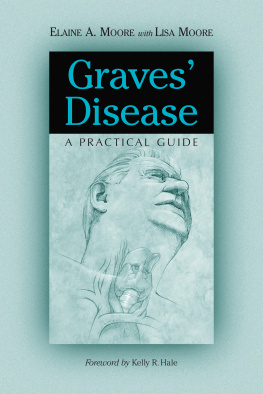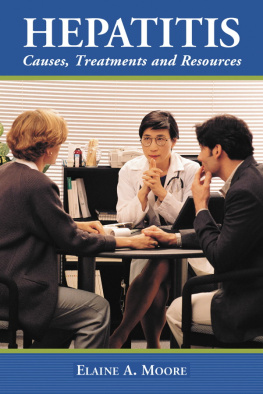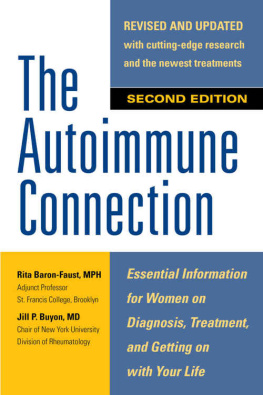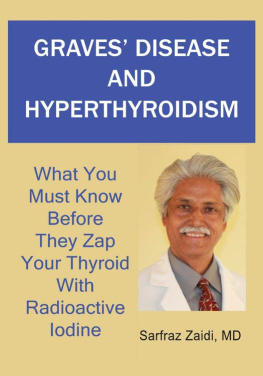Table of Contents
The information in this book is provided for educational purposes only. It is not intended as a substitute for medical treatment. The procedures and therapies described in this book should be discussed with a medical professional.
While all patient anecdotes are factual, in some instances the names and background of the individual, or both, have been changed to protect their privacy.
LIBRARY OF CONGRESS CATALOGUING DATA ARE AVAILABLE
e-ISBN: 978-0-7864-8748-6
BRITISH LIBRARY CATALOGUING DATA ARE AVAILABLE
2001 Elaine A. Moore and Lisa Moore. All rights reserved
No part of this book may be reproduced or transmitted in any form or by any means, electronic or mechanical, including photocopying or recording, or by any information storage and retrieval system, without permission in writing from the publisher.
Cover image 2001 Artville
McFarland & Company, Inc., Publishers
Box 611, Jefferson, North Carolina 28640
www.mcfarlandpub.com
To Arthur
Acknowledgments
This book could have never existed without the help and supportof many people. I particularly want to thank all my friends at http://groups.yahoo.com/group/graves_support, http://groups.yahoo. com/group/hyperTHYROIDISM2, and http://groups.yahoo.com/group/ graves=ALT=SEARCH, especially Julie, Mary, Randi, Jeannette, Julia and Red.
Id also like to thank my friend and coworker,
Marve Miller, for his generous help in illustrating this project and my daughter Lisa for her help in writing the resource chapter and for her encouragement every step of the way. Id also like to acknowledge the Mosby Year Book Company, W.B. Saunders Publishing Company, and Lippincott, Williams and Wilkins Publishing Company for their assistance. And special thanks to Kelly Hale at the American Foundation of Thyroid Patients, Nancy Patterson at the National Graves Disease Foundation and Virginia Ladd at the American Autoimmune and Related Diseases Association. And I cant forget Dr. Noel Rose, Dr. John Kennerdell and Dr. Leslie De Groot for the knowledge they so graciously shared. Also, sincere thanks to Kathy Nelson, Librarian at Eastern Idaho Regional Medical Center.
Id also like to express my gratitude to my husband Rick, my son Brett and my brothers, Ken, John, Richard and Bob for their support and countless hours of proofreading. And special thanks to my brother Arthur to whom this book is dedicated.
Foreword
Finally, a comprehensive manual to navigate Graves disease. When I was diagnosed with the disease in the early 90s, I was naive, and believed that the medical advice I was being given would pull me through and return me to my previous normal life.
Upon receiving this diagnosis, I requested information, the usual pamphlet found in many doctors offices. The staff looked at me as if I was asking for something quite unique and unheard of. I walked away empty-handed, and all too soon discovered that learning more about Graves disease would not be so easy.
Quite curious and somewhat distressed, I then began a hyper-mission to research Graves diseasewhy me, how to best treat, what to expect, and so on. This thought and effort led to the formation of the American Foundation of Thyroid Patients, a nonprofit organization dedicated to providing education to all patients with thyroid related diseases.
I am impressed and moved that Ms. Moore has shared her knowledge, time, and personal experience of Graves disease to help others who may find themselves in much the same situation as I once did.
Kelly R. Hale
Founder/President
American Foundation of Thyroid Patients
Introduction
Every science and every inquiry, and similarly every activity and pursuit, is thought to aim at some good.
Aristotle in Nichomachean Ethics
As a child, I rarely procrastinated. Unlike my brothers, I did my chores before going out to play. As an adult, I feared that if I ever fell behind, Id never catch up. Success and praise or abject failure loomed as the consequences. Never one to regard failure lightly, I hurdled my way through to do lists. However, when it came to Graves disease (GD), my system failed me. Then, I learned that alacrity has its own downside.
In college, years before my GD diagnosis, I learned that GD, a hyperthyroid disorder, results from a defective thyroid gland. At least thats what researchers thought in 1970. Had I known that, since then, GD had been found to have an autoimmune origin, I probably wouldnt have chosen aggressive treatment so hastily. Too late, I discovered that in GD, the thyroid is the victim, not the cause, and that the immune system is at fault.
What Ive since also learned is that every incidence of GD is unique, and no one treatment works best for all patients. Unlike diseases that always progressively worsen, symptoms in GD wax and wane with periods of variable severity and remission. Each year, 10 percent to 25 percent of GD patients achieve spontaneous remission. Then again, rarely, symptoms can skyrocket, causing heart problems, and, in rare instances, death.
Besides failing to research GD when it would have most benefited me, I also neglected to consider that certain personality traits Id developed were actually Graves symptoms, particularly my impatience and tendency to act impulsively. These very symptoms caused me to regard treatment as a line on a chore list, something to scratch off quickly. Considering the consequences, this is not a method I recommend following.
Enticed by reports of beneficial outcomes in other diseases, many Graves patients are consulting naturopath healers. In chapters 9 and 12, youll meet patients whove successfully used alternative medicine either alone or to complement conventional therapy. Although all GD patients need to be managed by a conventional or alternative practitioner, patients need to be involved in their own healing plans. Enthusiasm for a particular treatment affects both compliance and outcome.
Comprehensive in scope, this book is intended as a reference to be consulted whenever new issues surface. Several patients who critiqued early drafts worried that certain sections could intimidate some readers. Others insisted the same material was essential. I compromised by including figures to clarify the text, and I attempted to define obscure medical terms with their first use. Where I failed to do so, I apologize and hope I didnt neglect to include any of these words in the glossary. To help decipher the numerous thyroid acronyms we, in writing the resource sections, incorporated a list of acronyms into an encyclopedic medical glossary. This tool follows chapter 13.
One of the major consistencies in thyroidology lies in its inconsistencies. Reviewing the major endocrinology journals and textbooks, Ive found many conflicting views, particularly regarding treatment recommendations and diagnostic criteria.
In most instances, I included all views. Where this might have caused ambiguity or added to the confusion, I included the prevailing view. For discrepancies surrounding laboratory tests, I deferred to the pathologists, the doctors who oversee hospital laboratories, and to the research scientists who are instrumental in developing these tests.
Although science has made tremendous strides in elucidating the nature of Graves disease, there is still much more to be learned. Todays limited information will surely expand as researchers attempt to find not merely a treatment but a cure. In the meantime, I present an overview of current medical findings. And I offer you these suggestions for healing.
1 The Graves Legacy
A Gravesian Tale
I can rationalize stealing my brothers money by blaming it on my health. Since childhood, light, especially sunlight, has hurt my eyes. And although I loved playing outdoors, I could never keep from squinting even on hazy days. Until my theft, that is. Rifling through photo albums Im reminded of this. Particularly in several pictures taken with my twin on our third birthday, I appear to be in agony Im squinting and grimacing so fiercely. Its no wonder that at 7, the age of reason, I stole an older brothers three dollars and ran to Clarks, the corner drugstore, to buy sunglasses I later pretended to find.










